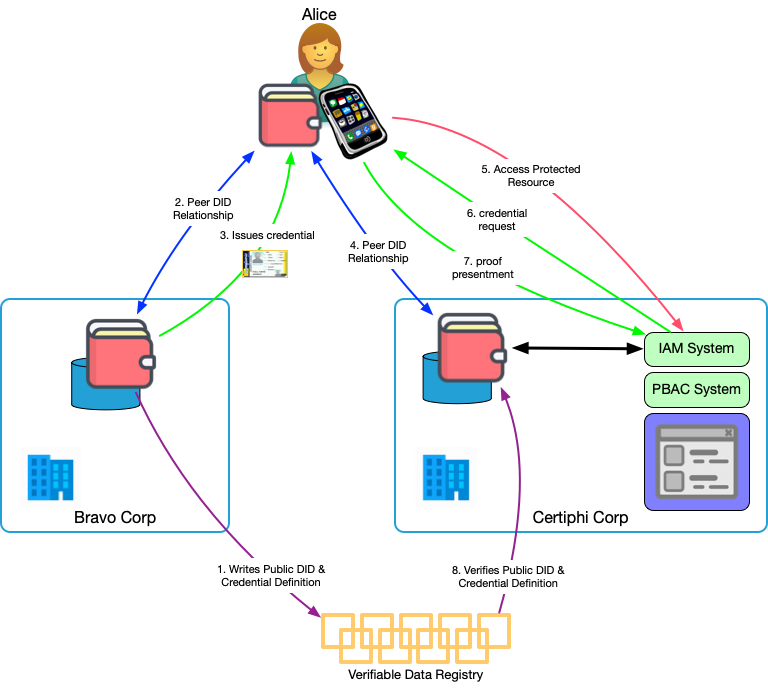Summary
What is decentralized identity and why is it important? My attempt at a simple explanation.

In Yeah, yeah, yeah, yeah, yeah, nah, Alan Mayo references my recent blog post, Decentralized Identity Comes of Age, and says:
My challenge to the decentralization community is for them (someone) to explain how it works in relatively simple and reasonable terms. I say relative because identity is not simple, so we should not expect simple solutions.
This post is my attempt to do that for Alan and others.
Identity is how we recognize, remember, react to, and interact with other people, organizations, and services. Put another way, identity is about relationships. Online we suffer from a proximity problem. Since we're not near the parties we want to have relationships with, our natural means of recognizing, remembering, and interacting with others can't be used. Digital identity systems are meant to provide us with the means of creating online relationships.
Traditional identity systems have not served us well because they are owned and controlled by companies who build them for their own purposes. The relationships they support are anemic and transactional. We can't use them for any purpose except what their owner's allow.
Decentralized identity systems1 on the other hand allow you to create online relationships with any person, organization, or service you choose and give you the tools to manage and use those relationships. They help you recognize, remember, react to, and interact with them. The most important tool is a decentralized identity wallet. The world of decentralized identity wallets is still young, but organizations like the Linux Foundation's Open Wallet Foundation give me hope that useful, interoperable wallets are a tool we'll all be able to use soon. They are as foundational to decentralized identity as a browser is to the web.
Besides helping you manage peer-to-peer relationships with others online, wallets hold verifiable credentials, the digital analog to the credentials and cards you carry in a physical wallet. One of the most important aspects of digital relationships is providing information about yourself to those you interact with. Sometimes that information can come from you—it's self-asserted—but many times the other party wants to reliably know what others say about you. For example, if you establish a banking relationship, the bank is legally obligated to verify things like your name and address independent of what you say. Decentralized identity wallets allow you to prove things about yourself using credentials others provide to you. At the same time, they protect your privacy by limiting the information disclosed and forgoing the need for the party you're interacting with to directly contact others to verify the information you provide.
In summary, decentralized identity systems allow you to create digital relationships with other parties independently, without relying on any other organization or service. These relationships are direct, private, and secure. They also provide the means for you to prove things about yourself inside these relationships so that even though you're operating at a distance, you and the other party can have confidence in the relationship's authenticity.
How Does It Work
The preceding paragraphs say what decentralized identity is, and provide its benefits, but don't say how it works. Alan and others will likely want a few more details. Everything I describe below is handled by the wallet. The person using the wallet doesn't need to have any more knowledge of how they work than the operator of a browser needs to understand HTTP and HTML.
The foundation of a peer-to-peer, decentralized online relationship is an autonomic identifier like a peer DID. Identifiers are handles that someone else can use to identify someone or something else online. Peer DIDs can be created by a wallet at will, they're free, and they're self-certifying (i.e., there's no need for a third party). A relationship is created when two identity wallets create and exchange peer DIDs with each other on behalf of their owners. Peer DIDs allow the parties to the relationship to exchange private, secure messages.
There are four primary interaction patterns that wallets undertake when exchanging messages:
- DID Authentication which uses the DIDs to allow each party to authenticate the other
- Single-Party Credential Authorization where the same party issues and verifies the credential.
- Multi-Party Authorization where the credential issuer and verifier are different parties.
- Generalized Trustworthy Data Transfer which uses a collection of credentials to aid the wallet owner in completing online workflows.

Verifiable credentials make heavy use of cryptography to provide not only security and privacy, but also confidence that the credential data is authentic. This confidence is based on four properties a properly designed credential presentation protocol provides:
- The identifier of the credential issuer
- Proof that the credential is being presented by the party is was issued to
- Proof that the credential has not been tampered with
- The revocation status of the credential
The credential presentation can do all this while only disclosing the information needed for the interaction and without the verifier having to contact the credential issuer. Not having to contact the issuer ensures the credential can be used in situations with poor connectivity, that the issuer needn't be online, and preserves the credential subject's privacy about where the credential is being used.
A properly designed credential exchange protocol has four important properties:
- The system is decentralized and contextual. There is no central authority for all credentials. Every party can be an issuer, an owner, and a verifier. The system can be adapted to any country, any industry, any community, any set of credentials, any set of trust relationships.
- Issuers are free to determine what credentials to issue and whether or not to revoke them.
- Wallet owners are free to choose which credentials to carry and where and when they get shared. While some verifiers require a specific credential—such as a customs agent requiring a passport—others will accept a range of credentials. Therefore owners can decide which credentials to carry in their wallet based on the verifiers with whom they interact.
- Verifiers make their own decisions about which credentials to accept. For example, a bar you are trying to enter may accept any credential you have about your date of birth. This means some credentials (e.g., passports, driving licenses, birth certificates) may be much more useful than just for the original purpose for which they were issued.
These properties make a decentralized identity system self sovereign.
Why is Decentralized Identity Important?
Decentralized identity systems are designed to provide people with control, security, and privacy while enhancing the confidence we have in our online relationships. Some time ago, I wrote the following. I think it's an apt way to close any discussion of decentralized identity because unless we keep our eyes on the goal, we'll likely take shortcuts in implementation that fail to live up to their promise.
Presently, people don't have operational relationships anywhere online.2 We have plenty of online relationships, but they are not operational because we are prevented from acting by their anemic natures. Our helplessness is the result of the power imbalance that is inherent in bureaucratic relationships. The solution to the anemic relationships created by administrative identity systems is to provide people with the tools they need to operationalize their self-sovereign authority and act as peers with others online. Peer-to-peer relationships are the norm in the physical world. When we dine at a restaurant or shop at a store in the physical world, we do not do so under the control of some administrative system. Rather, we act as embodied agents and operationalize our relationships, whether they be long-lived or nascent, by acting for ourselves. Any properly designed decentralized identity system must provide people with the tools they need to be "embodied" in the digital world and act autonomously.
Time and again, various people have tried to create decentralized marketplaces or social networks only to fail to gain traction. These systems fail because they are not based on a firm foundation that allows people to act in relationships with sovereign authority in systems mediated through protocol rather than by the whims of companies. We have a fine example of a protocol mediated system in the internet, but we've failed to take up the daunting task of building the same kind of system for identity. Consequently, when we act, we do so without firm footing or sufficient leverage.
Ironically, the internet broke down the walled gardens of CompuServe and Prodigy with a protocol-mediated metasystem, but surveillance capitalism has rebuilt them on the web. No one could live an effective life in an amusement park. Similarly, we cannot function as fully embodied agents in the digital sphere within the administrative systems of surveillance capitalists, despite their attractions. The emergence of self-sovereign identity, agreements on protocols, and the creation of metasystems to operationalize them promises a digital world where decentralized interactions create life-like online experiences. The richer relationships that result from properly designed decentralized identity systems promise an online future that gives people the opportunity to act for themselves as autonomous human beings and supports their dignity so that they can live an effective online life.
Notes
- I prefer the term self-sovereign to decentralized because it describes the goal rather than the implementation, but I'll stick with decentralized here. All self-sovereign identity systems are decentralized. Not all decentralized identity systems are self-sovereign.
- The one exception I can think of to this is email. People act through email all the time in ways that aren't intermediated by their email provider. Again, it's a result of the architecture of email, set up over four decades ago and the culture that architecture supports.
Photo Credit: Young Woman Using a Wallet from DALL-E (public domain) Prompt: draw a rectangular picture of a young woman using a wallet.




